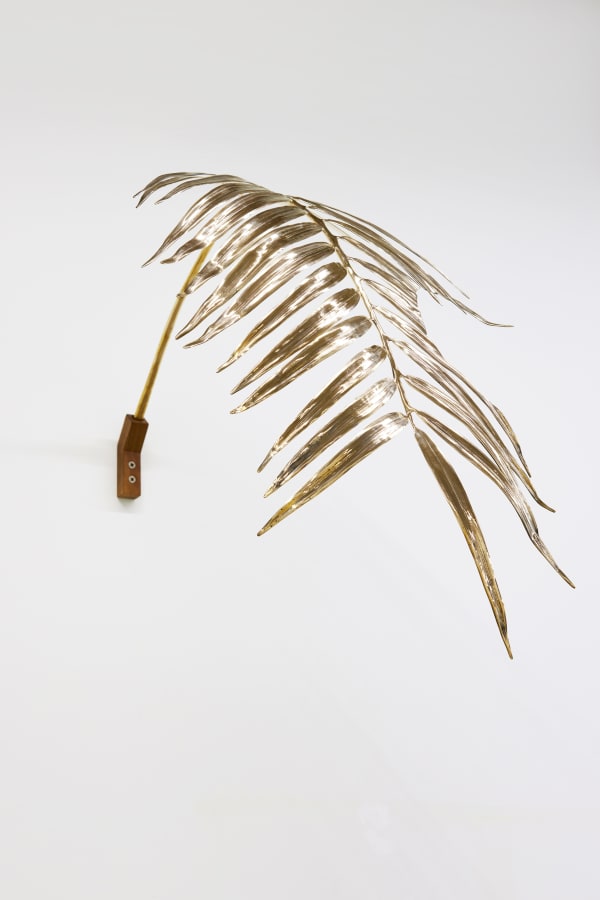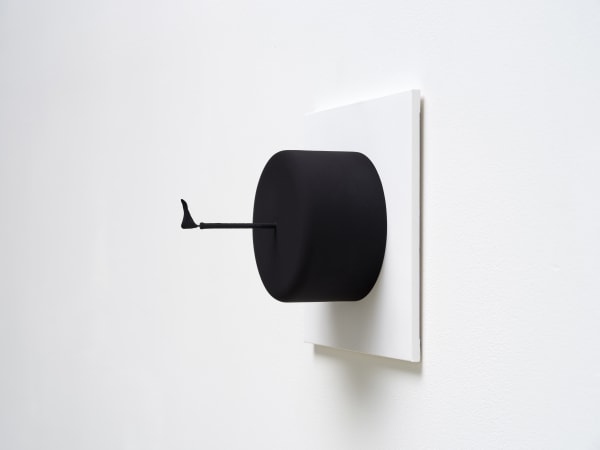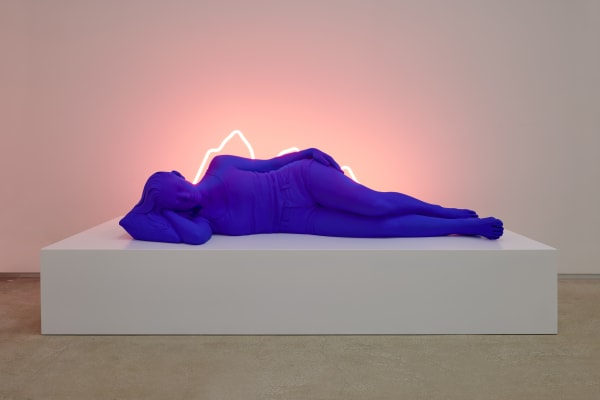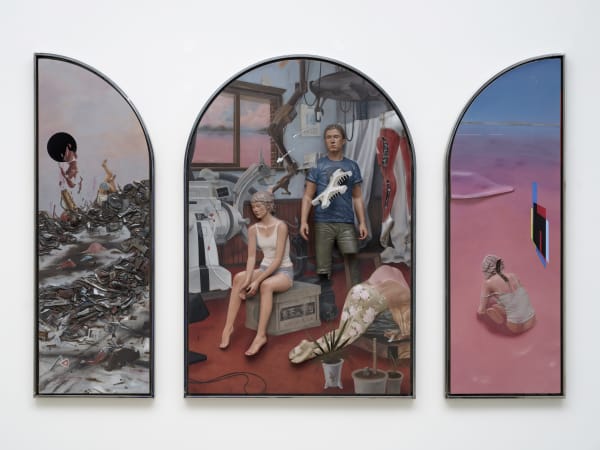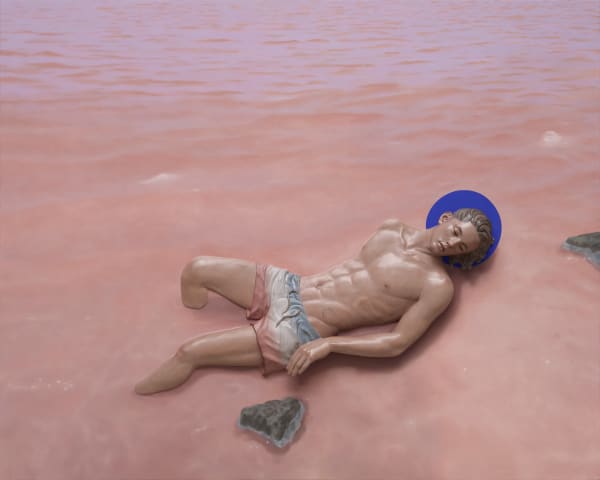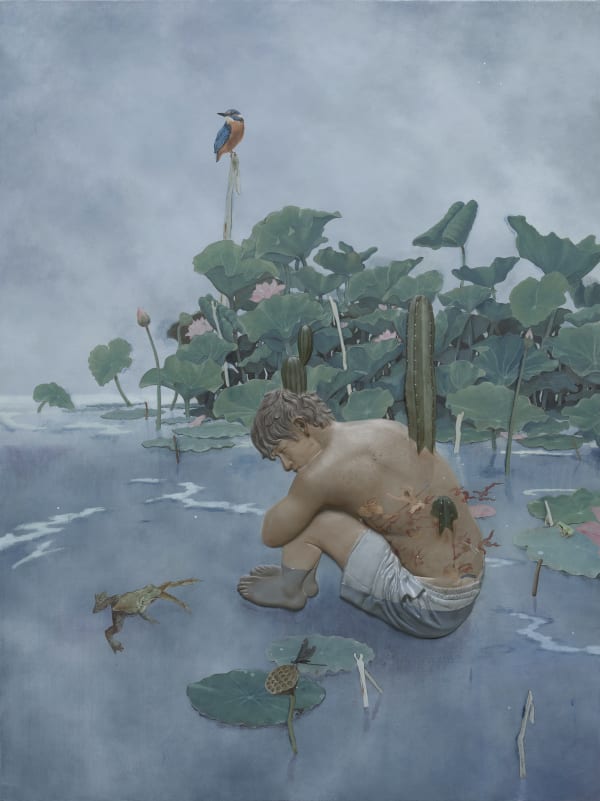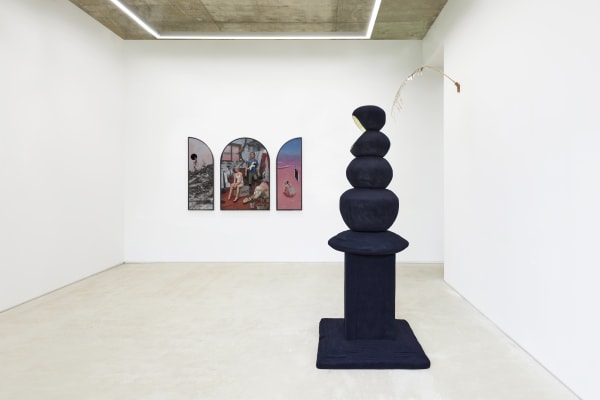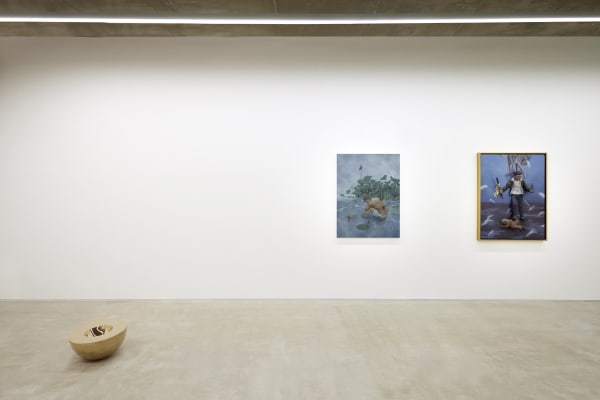식(蝕) Sik: 신건우 Gunwoo Shin
신건우 개인전 <蝕>은 먹을 ‘식(食)’자에 벌레 ‘충(蟲)자를 쓰는 좀먹을 ‘식’자다. ‘식’은 먹어 들어간다는 뜻이니 마이너스의 요소다. 반대로 인간을 비롯해 물질은 존재하는 것이니 플러스 요소라고 할 수 있다. 세상은 이렇게 현실적인 것과 이상적인 것, 의식과 무의식, 물질과 비물질, 존재와 부재, 탄생과 죽음 등 플러스 요소와 마이너스 요소가 공존한다고 작가는 말한다. 그는 이번 전시를 통해 우리가 눈으로 볼 수 없지만 ‘존재’하는 것을 작품으로 표현하고자 했다. 형태가 없는 ‘어떤 것’, 그러나 분명 ‘존재하는 것’. 이것을 표현하기 위한 개념이 바로 ‘식’이다.
신과 종교, 신화, 인간의 무의식 등 그가 오랫동안 탐구해온 주제 역시 같은 맥락이라고 할 수 있다. 이렇게 추상적이고 포괄적인 개념을 형태로 구체화 시키는데 모티프가 된 것은 관엽식물인 몬스테라(Monstera)다. 몬스테라는 열대성 기후의 많은 비를 이겨내기 위해 잎에 구멍이 나 있는데, 작가는 이러한 생태적인 이유와 별개로 잎에 생긴 기이한 구멍에 관심을 두게 됐다. 자연적인 잎의 형태에 마치 추상적인 원형이 ‘먹어 들어가는 듯한’ 형상은 우리의 삶에 내재된 비가시적인 존재의 형상으로 치환되었다.
그동안 부조를 주로 선보여 온 신건우는 이번 전시에서 조각에 주력했다. 그는 부조를 완성하기 위한 화면의 내러티브와 복잡한 제작 과정을 생략하고 더 간단명료하게 ‘식’을 표현하고 싶었다고 한다. 이를 주제로 가장 먼저 제작한 작품은 야자수 조화를 브론즈(청동)로 캐스팅한 <Hole in Palm Leaves>인데, 야자수 잎에 원형으로 구멍을 낸 작품이다. 어떤 형태로 ‘식’을 표현할까 고민한 끝에 작가는 원형으로 결정했다. 조형적인 아름다움도 있지만, 무엇보다 원형이 갖는 상징성이 큰 이유가 되었다. 작가는 원형의 의미를 추적해 보면 이는 고대부터 신성시된 형태였다고 말한다. 부처의 나발이나 두광, 천사나 성인(聖人)의 머리 위에 동그란 빛인 헤일로, 인간이 닿을 수 없는 해와 달 역시 원형이다.
<식-Blue Pagoda>와 <식-Black Pagoda>는 실제로 춘천 서상리의 삼층석탑과 화순 운주사의 발형 다층석탑을 모각한 작품이다. 이 또한 원형이 탑의 일부를 먹어 들어가고 있다. 작가가 여행하면서 본 실제 탑이 작업의 모티프가 되었다. 하지만 작가는 탑이 큰 의미가 있는 것이 아니라 그저 여행길에 만난 탑의 형태가 눈에 띄었기 때문이라고 한다. 탑의 의미나 형태가 중요한 것이 아니라 세상에는 비가시적인 영역이 존재한다는 사실을 표현하기 위한 하나의 수단일 뿐이다. 그것이 인간이든 식물이든 사물이든.
‘식’의 개념을 인식하고 나서 부조 작업에도 변화가 생겼다. 기존의 작업에는 거대한 내러티브가 있었지만, 이번 신작에서는 어떤 이야기를 설명하기보다는 하나의 간결한 장면을 보여주면서 그 ‘이면’에 있는 것을 표현하고자 했다. 화면이 단순해진 만큼 중심이 되는 인물은 더욱더 세밀하게 묘사되었다. <Thousand Hands>는 의자에 앉은 인물이 손짓으로 원을 만드는 모습을 묘사했다. 이 작업은 마치 천수관음보살의 모습을 정면이 아닌 측면에서 보는 듯하다. 천 개의 손과 천 개의 눈으로 중생을 구제한다는 천수관음보살의 존재는 매우 이상적이면서도 인간애를 담고 있다. <Blue Candle Boy>는 연꽃밭 안에서 선인장을 틔우는 인물을 묘사한다. 물 안에서 웅크린 인물은 물이 필요 없는 선인장을 길러내기 위해 희생하고 인내하는 모습을 보여준다. 부조 안의 인물들은 어딘가 구도자, 수행자 그리고 성인(聖人)의 모습을 연상시킨다. 종교적인 믿음이나 이상(理想)을 추구하는 그들의 모습은 조각에서 원형으로 표현된 ‘식’을 구체적인 대상으로 표현한 것이다.
신건우의 이번 전시는 15년 동안의 작업을 되돌아본다는 점에서 큰 의미가 있다. 자신의 작업을 복기했을 때, 시기마다 신이나 종교, 신화, 사회 문제 등 관심을 가졌던 주제는 다르지만 묘하게 자신이 찾고자 하는 대상이 모든 작업에 들어있었다고 한다. 그 안에서 작가는 뭔가 관통하는 흐름을 인식하게 됐으며 기존의 개념이나 단어로 명명할 수 없는 그 흐름을 ‘식’이라고 명명했다. 그는 앞으로 작업은 계속 변하겠지만 이 주제는 변하지 않을 것 같다고 말한다. ‘식’이 세상에 존재한다는 사실 역시 변하지 않을 것이다.
Sik, the title of Gunwoo Shin's solo exhibition comes from the Sino-Korean character 蝕, meaning "to eat into, erode, encroach upon, or eclipse." It is a compound character of the radicals 食 and 蟲, meaning to eat and insect, respectively. The visual metaphor of Sik overlaps with the Latin root rodere, meaning to gnaw, to take away; subtract. What then, is to exist as people, as things, as matter? Perhaps it is the opposite of subtraction; addition. Shin explains that the world is a coexistence of opposites: addition and subtraction, real and ideal, conscious and unconscious, materiality and immateriality, presence and absence, birth and death. Through his works presented in this exhibition, he sought to express existence that is not tangible to the eye. Things that exist without form. Sik encompasses the concept adequately.
The artist's ongoing exploration of themes such as gods, religion, mythologies, and the human unconscious all tie into the trajectory of Sik. The artist looked to Monstera, a species of evergreen tropical vine cultivated as houseplants, as the motif embodying this abstract and comprehensive concept in physical form. Monstera is also called the "Swiss cheese plant" as its gorgeous leaves are fenestrated - developed holes in its leaves - as an evolutionary adaptation to monsoons in tropical climate. Shin's interest was not in its natural biome, but the perforations. The natural shape of the leaf was perforated with what may be seen as "gnawed in" holes, a permutation of our invisible realities.
Gunwoo Shin's previous works were mainly relief-based, but this exhibition features sculptures. He shares that the intention was to express Sik in a more concise manner, without the convoluted relief-process which required a screen narrative and a laborious production process. The first artwork Shin created for this theme was the bronze-cast ⟨Hole in Palm Leaves⟩, in the form of a branch from a palm tree. There is a noticeable section missing in the cast, as if a large machine or animal clipped it. Deciding the shape of this Sik was a difficult task, one which he ultimately chose to be circular. The branch-leaf is sculpturally pleasing, but it is the missing circular portion of the branch-leaf that holds symbolic significance. The artist traces back the significance of the circle as being a form considered sacred since ancient times. The most accessible example in the East would be the curly hair of Buddha (legend states it became that way upon enlightenment) and his radiant mandorla. Halos above or behind angelic figures and saints' heads is a common example in the West. The sun and the moon and the heavens - inaccessible to mortals - is also represented in this circular form.
⟨Sik-Blue Pagoda⟩ and ⟨Sik-Black Pagoda⟩ are the artist's sculptural recreation of the Seosang-ri Three-story Stone Pagoda in Chuncheon and the Circular stone Pagoda in Unjusa Temple in Hwasun. These sculptures also appear to have been eclipsed upon. The artist encountered these historical pagodas as motifs for artwork while traveling. It wasn't that the towers themselves had a historical significance; it was simply the shape of the tower that caught his attention while traveling through. There is little to unpack behind the names and the historicity of these pagodas; other than their means of expressing the presence of the unseeable in this reality. It could be people, plants and creatures, or just things.
The artist’s relief works were also informed by his increasing awareness and exploration of Sik. Shin’s previous works often featured a giant narrative that served as an undercurrent carrying his presented works, but he takes a carousel slide show-esque approach to present simple scenes that convey of something beyond what is tangible. As the frame was simplified, the focal characters were depicted with finer detail. ⟨Thousand Hands⟩ is a figure in a chair making circular gestures. It appears to be a side-view of the Avalokiteśvara Bodhisattva (千手千眼觀世音菩薩), the female-form (Guanyin) who embodies the compassion of all Buddhas, a perspective less common to the usual forward-facing posture. The Bodhisattva with a thousand hands and a thousand eyes that will bring salvation to the people couldn't be more ideal and at the same time, a human concept. ⟨Blue Candle Boy⟩ depicts a character sprouting a cactus out of his body in a lotus pond. His crouched body partially submerged, the character is suffering and persevering through pain to grow a cactus necessarily does not require so much water - much less a pond. Characters within Gunwoo Shin's works evoke notions of catechumen, ascetic seekers of enlightenment, and saints. Their pursuit of religious beliefs or ideals have been expressed as eclipses or Sik, in Shin's sculptures.
This solo exhibition marks Gunwoo Shin's 15th year of work. Upon looking back on his works, Shin shares that through periods of interest and inquisition on topics of gods, religion, mythologies, and society, the themes appeared different, but the answers he was seeking were found in all his artworks. Through such discoveries, he became aware of a permeating flow, and as his senses could not justify this awareness through words, chose instead to call it Sik. He expects his works to continue evolving and exploring, but never be far from this ongoing theme. Sik exists as a presence, and that too, will never change.


